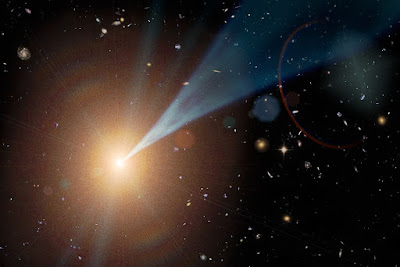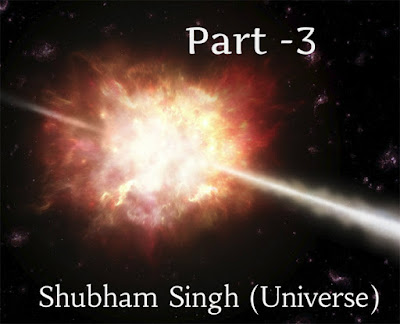Translate in your Language
Saturday 25 March 2017
Dazzling thing in the Universe {Part -1}
Welcome to the Series of Dazzling thing in the Universe:- (Part -1)
The above symbol is called Yin Yang, it is a Taijitu meaning diagram of the supreme ultimate.
 |
| Yin Yang |
The principle of Yin Yang opposites existing in harmony, is associated with ancient Chinese philosophy.
But the very first use of the iconography the class symbol,, actually comes from a Shield pattern used by the ancient Romans 700 years before.
Its first known use in China.
A connection between the two yet to be found. Regardless of who came up with it first, the symbol was a bright idea.
But what's the brightest thing in the Universe?
Commonly used when stargazing refers to how bright an object appears to us, say when looking up from Earth.
It depends upon Earth-centric factors, like how close the object is to our planet.
Magnitudes are logarithmic and arranged like golf, where a smaller number means a greater brightness.
But today, I'm looking for Absolute Magnitude, a measure of how bright things all over the Universe near and far would be if we looked at them from the same distance.
Absolute Magnitude will guide us to the most blending light in the Universe, irrespective of it looking faint to us here on Earth, just because its far away.
The difference is significant.
A 100-watt light bulb placed closer than 8 centimetres will appear brighter than the Sun in the sky. But that's not fair.
If you could see the Sun and the bulb from the same distance, the Sun would be a septillion times brighter.
That's bright.
If you could line up the Sun up with everything else out there giving every star a cosmological phenomena, a fair chance, the Sun's Absolute Magnitude would 4.8.
But check out R136a1. This star isn't the brightest star in terms of volume but it is 256 times more massive than our Sun.
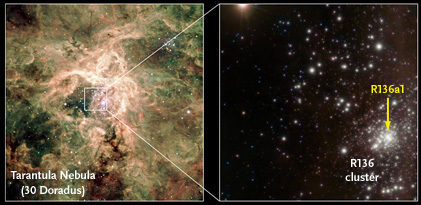 |
| R136a1 |
It's the most massive star ever found and it's also the brightest.
Tuesday 14 March 2017
Hottest thing in the Universe {Part -4}
Welcome to the Series of Hottest thing in the Universe:- (Part -4)
Okay, what if we add even more energy?
Wouldn't the wavelength get smaller? It's supposed to, but yet it ain't. This is where we've got a problem.
Above 1.41 times to 32 kelvin, the Planck temperature, our theories don't work.
The object would become hotter than temperature. It would be so hot that what it is would not be considered a temperature.
Theoretically, there is no limit to the amount of energy we could keep adding into the system. We just don't know what would happen if it got hotter than the Planck temperature.
Classically, you could argue that that much energy in one place would instantly cause a Black Hole (don't forget to check my other posts- "Journey to the Black Hole") to form.
And a Black Hole formed from energy has a special name- a Kugelblitz.
So, basically, what I'm trying to say is when you want to tell someone you like that you think they are hot,so hot that not even science can understand it, Just call them a Kugelblitz.
Finally, here is something fun.
The Sun is about 4.7 billion years old, about halfway through its life cycle and so far it has burned 100 Earths worth of fuel,
which sounds like a lot, but the Sun is the size of 300,000 Earths.
Because of that discrepancy, you can have a lot of mathematical fun comparing your energy output to the Sun's.
The Sun is way hotter than us and it puts out way more energy than us.
Some websites have a lot of fun with this one and although it doesn't really mean anything anything, it is technically true,
because of the Sun's enormous size, that one cubic centimeter of human puts out more energy than an average cubic centimeter of the Sun, which should make you feel quite warm inside.
Okay, what if we add even more energy?
Wouldn't the wavelength get smaller? It's supposed to, but yet it ain't. This is where we've got a problem.
Above 1.41 times to 32 kelvin, the Planck temperature, our theories don't work.
The object would become hotter than temperature. It would be so hot that what it is would not be considered a temperature.
Theoretically, there is no limit to the amount of energy we could keep adding into the system. We just don't know what would happen if it got hotter than the Planck temperature.
Classically, you could argue that that much energy in one place would instantly cause a Black Hole (don't forget to check my other posts- "Journey to the Black Hole") to form.
And a Black Hole formed from energy has a special name- a Kugelblitz.
So, basically, what I'm trying to say is when you want to tell someone you like that you think they are hot,so hot that not even science can understand it, Just call them a Kugelblitz.
Finally, here is something fun.
The Sun is about 4.7 billion years old, about halfway through its life cycle and so far it has burned 100 Earths worth of fuel,
which sounds like a lot, but the Sun is the size of 300,000 Earths.
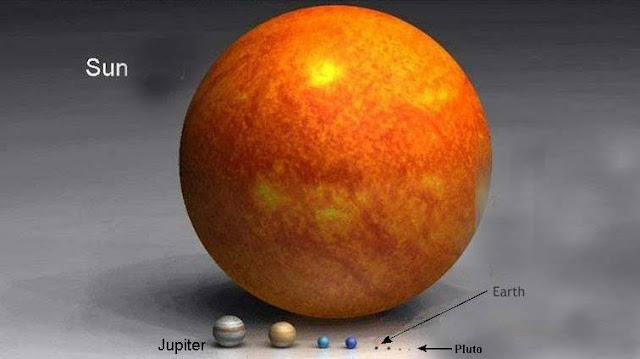 |
| Planets in our Solar System compared to the Sun |
Because of that discrepancy, you can have a lot of mathematical fun comparing your energy output to the Sun's.
The Sun is way hotter than us and it puts out way more energy than us.
 |
| The Sun |
Some websites have a lot of fun with this one and although it doesn't really mean anything anything, it is technically true,
because of the Sun's enormous size, that one cubic centimeter of human puts out more energy than an average cubic centimeter of the Sun, which should make you feel quite warm inside.
Saturday 11 March 2017
Hottest thing in the Universe {Part -3}
Welcome to the Series of Hottest thing in the Universe:- (Part -3)
Let's get hotter. At 1 TeraKelvin things get weird. Remember that Plasma (in Part-2 of the series- Hottest thing in the Universe) we were talking about that the Sun is made of?
Well at TeraKelvin, the electrons aren't the only thing that wander away.
The hedrons themselves, the protons and neutrons in the nucleus melt into quirks and gluons, sort of soup.
But how hot is a TeraKelvin? Frighteningly hot.
There's a Star named WR 104, about 8,000 light years away from us.
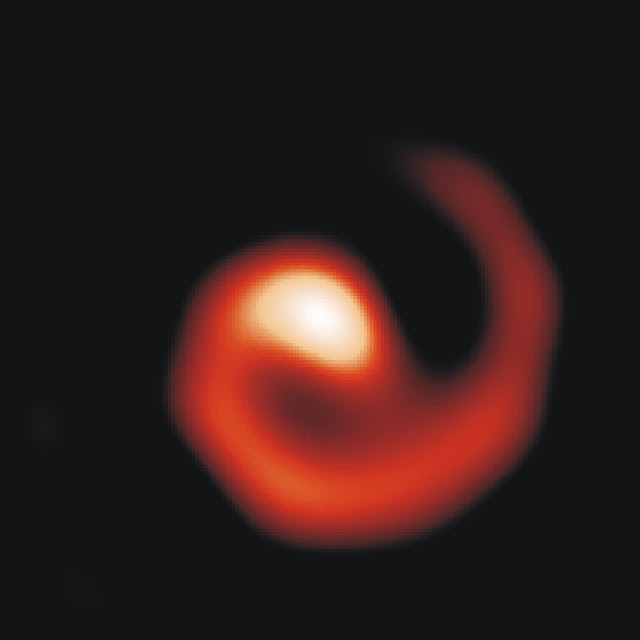 |
| WR 104 |
It's mass is the equivalent of 25 of our Suns and when it dies, when it collapses, its internal temperature will be so great that the energy emitted, the Gamma Radiation it flings out into space will be stronger than the entire amount of energy our Sun will ever create in its entire lifetime.
Gamma ray bursts are quite narrow, so Earth is most likely safe, but what if it wasn't?
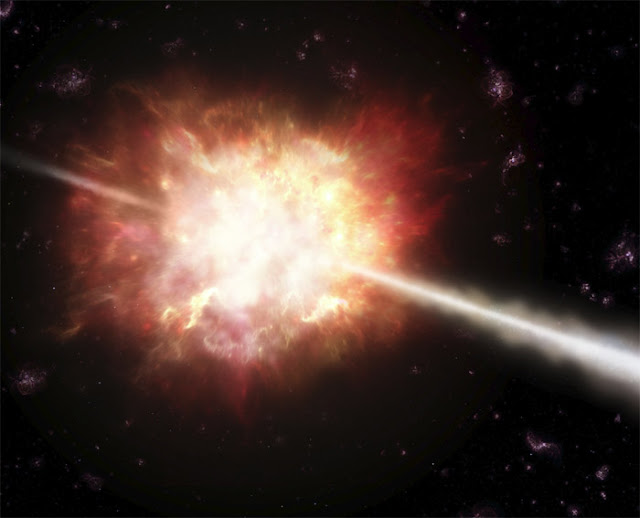 |
| Gamma Ray Bursts |
Well, when WR 104 collapses, even though Earth is 4,702 trillion miles away, the energy it releases would still be bad news.
Exposure for 10 seconds would mean losing a quarter of Earth's Ozone layer, resulting in mass extinction, food chain depletion and starvation from 8,000 light years away.
Closure to home, right here on Earth in Switzerland, scientists have been able to smash protons to nuclei, resulting in temperatures much larger than 1 TeraKelvin = 1,000,000,000,000 K.
They've been able to reach 2 to 12 ExaKelvin range.
1 ExaKelvin = 1,000,000,000,000,000,000 K.
Bet we are okay because those temperatures last for an incredibly brief moment and only involve a small number of particles.
Remember, how we could calculate the wavelength of of the radiation emitted by an object based on its temperature? (in Part - 2 of this Series)
Well if an object were to reach a temperature of 1.41 times to the 32 Kelvin .
(255,000 billion billion billion °F
or
141,000 billion billion billion °C)
The Radiation it would emit would have a wavelength of 1.616 times 10 to the negative 26th nano meters, which is tiny.
Like so tiny, it actually has special name.
It is the Planck Distance, which according to quantum mechanics, it is the shortest distance possible in our Universe.
Tuesday 7 March 2017
Hottest thing in the Universe {Part -2}
Welcome to the Series of Hottest thing in the Universe:- (Part -2)
If you were to heat the head of the pin to the temperature of the centre of the Sun, it would kill any person within 100 miles of it.
The energy emitted by an object often tells us a lot about the temperature of that object.
Any object over absolute zero emits some form of electromagnetic radiation.
You and me, we don't glow visibly, but we do emit infrared light.
We can't see it, but infrared cameras can.
WBT has great videos and in that video, the infrared camera is hidden inside an opaque black trash bag. Now, we can't see him, but his body is infra-redly glowing through it.
If you want something to be the right temperature to glow in the visible spectrum, you'll have to reach the Drapper Point about 798 kelvin (976°F or 525°C).
At this point , almost any object will begin to glow a dead red.
We can calculate the expected wavelength of radiation coming off of an object because of its temperature and that wavelength gets smaller and smaller the hotter and hotter the object gets.
It goes from radio waves to microwaves up through infrared divisible, all the way to X-rays and Gamma rays, which are created in the middle of our Sun.
At temperatures as hot as the Sun matter exists in a fourth state. Not solid, not liquid, not gas but instead, a state where the electrons wander away from the nuclei- Plasma.
Besides, our Sun isn't even close to being the hottest thing in the Universe. I mean sure, 15 million kelvin is pretty incredible, but the peak temperature reached during a thermonuclear explosion is 350 million kelvin, which hardly counts because the temperature is achieved so briefly.
But inside the core of a Star, 8 times larger than our Sun, on the last day of its life, as it collapses in on itself , it would reach a temperature of 3 Billion kelvin or 3 Gigakelvin.
If you were to heat the head of the pin to the temperature of the centre of the Sun, it would kill any person within 100 miles of it.
The energy emitted by an object often tells us a lot about the temperature of that object.
Any object over absolute zero emits some form of electromagnetic radiation.
You and me, we don't glow visibly, but we do emit infrared light.
We can't see it, but infrared cameras can.
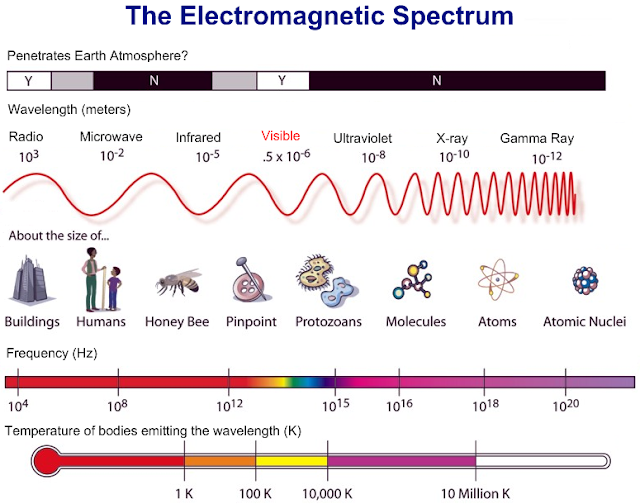 |
| Electromagnetic Radiation |
WBT has great videos and in that video, the infrared camera is hidden inside an opaque black trash bag. Now, we can't see him, but his body is infra-redly glowing through it.
If you want something to be the right temperature to glow in the visible spectrum, you'll have to reach the Drapper Point about 798 kelvin (976°F or 525°C).
At this point , almost any object will begin to glow a dead red.
We can calculate the expected wavelength of radiation coming off of an object because of its temperature and that wavelength gets smaller and smaller the hotter and hotter the object gets.
It goes from radio waves to microwaves up through infrared divisible, all the way to X-rays and Gamma rays, which are created in the middle of our Sun.
At temperatures as hot as the Sun matter exists in a fourth state. Not solid, not liquid, not gas but instead, a state where the electrons wander away from the nuclei- Plasma.
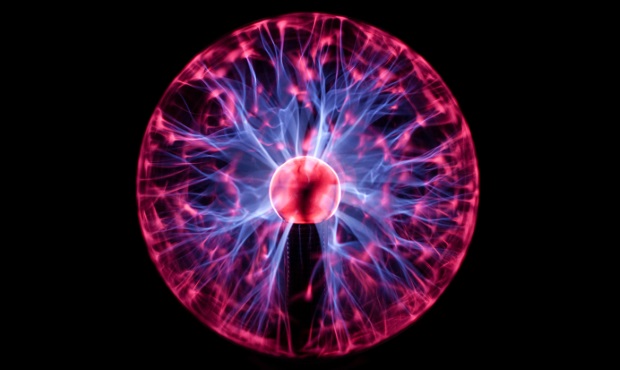 |
| Plasma |
Besides, our Sun isn't even close to being the hottest thing in the Universe. I mean sure, 15 million kelvin is pretty incredible, but the peak temperature reached during a thermonuclear explosion is 350 million kelvin, which hardly counts because the temperature is achieved so briefly.
 |
| Thermonuclear Explosion |
Monday 6 March 2017
Hottest thing in the Universe {Part -1}
Welcome to Series of Hottest thing in the Universe:- (Part - 1)
So what is the hottest thing in the Universe?
As we know that there is an absolute zero, but is there an absolute hot?
A point at which something is so hot, it can't get any hotter. Well to find out, let's begin with the human body.
Your internal temperature is not constant at all. 37°C (98.6°F) sure but these are averages. Your body's internal temperature fluctuates by about 1°F or half a °C throughout a day in a cycle.
Assuming you sleep at night, at 4:30 in the morning, your body reaches its coolest natural healthy temperature and at 7:00 in the evening, it reaches its highest.
But dangerous fever is not good.
108°F or 42°C is almost always lethal.
The highest recorded air temperature across all of the Earth has happened four times in the Death Valley, where it has reached 129°F (54°C).
180°F (82°C) is the recommended temperature for water, when brewing coffee.
210°F (99°C) a cake is done.
2000°F (1090°C) is the temperature of lava fresh outta the ground.
But you can your own lava, like Green Science Pro. This man uses Fresnel Lenses to focus the Sun's energy onto whatever he wants.
Keep in mind that the Sun is having that effect even though it is 93 million miles (149,600,000 km) away from Earth.
Right up on the surface of the Sun is a different story. The surface clocks in at 10,000°F (5,500°C),but the centre, where fusion occurs is ridiculous. Temperatures there reach 28 million °F (15 milion °C), which is also known as 15 million kelvin.
The kelvin scale has unit that are the same size as a Celsius degree but it's an absolute, where 0 is an absolute zero.
When matter reaches temperatures as high as those found in the centre of the Sun, an enormous amount of energy is radiated away.
So what is the hottest thing in the Universe?
As we know that there is an absolute zero, but is there an absolute hot?
A point at which something is so hot, it can't get any hotter. Well to find out, let's begin with the human body.
Your internal temperature is not constant at all. 37°C (98.6°F) sure but these are averages. Your body's internal temperature fluctuates by about 1°F or half a °C throughout a day in a cycle.
Assuming you sleep at night, at 4:30 in the morning, your body reaches its coolest natural healthy temperature and at 7:00 in the evening, it reaches its highest.
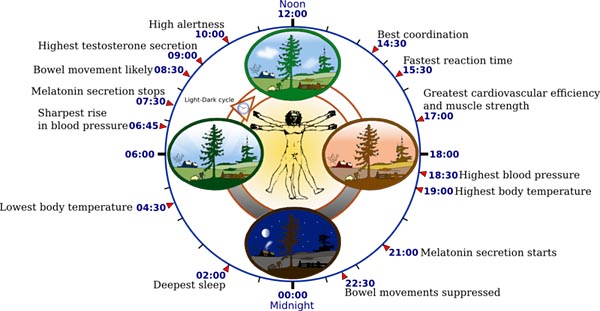 |
| Regulation of human body temperature |
But dangerous fever is not good.
108°F or 42°C is almost always lethal.
The highest recorded air temperature across all of the Earth has happened four times in the Death Valley, where it has reached 129°F (54°C).
180°F (82°C) is the recommended temperature for water, when brewing coffee.
210°F (99°C) a cake is done.
2000°F (1090°C) is the temperature of lava fresh outta the ground.
But you can your own lava, like Green Science Pro. This man uses Fresnel Lenses to focus the Sun's energy onto whatever he wants.
Keep in mind that the Sun is having that effect even though it is 93 million miles (149,600,000 km) away from Earth.
Right up on the surface of the Sun is a different story. The surface clocks in at 10,000°F (5,500°C),but the centre, where fusion occurs is ridiculous. Temperatures there reach 28 million °F (15 milion °C), which is also known as 15 million kelvin.
The kelvin scale has unit that are the same size as a Celsius degree but it's an absolute, where 0 is an absolute zero.
When matter reaches temperatures as high as those found in the centre of the Sun, an enormous amount of energy is radiated away.
Subscribe to:
Posts (Atom)






